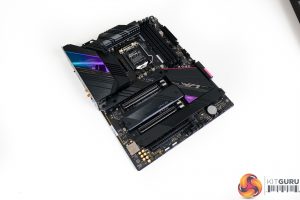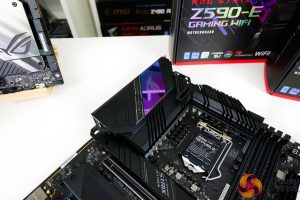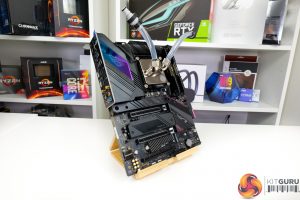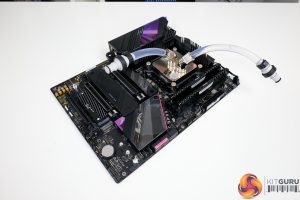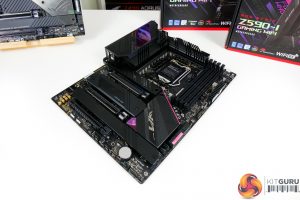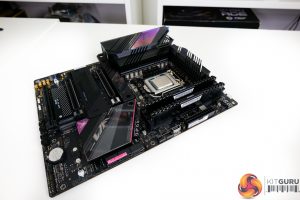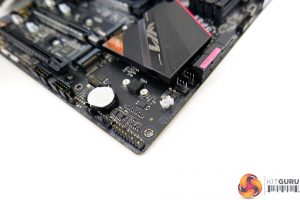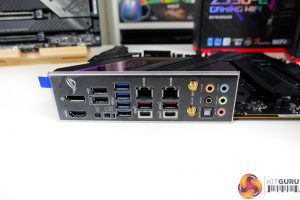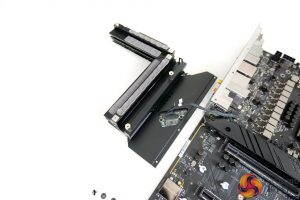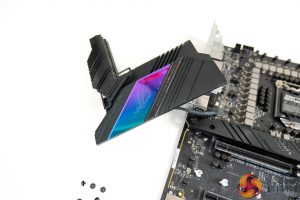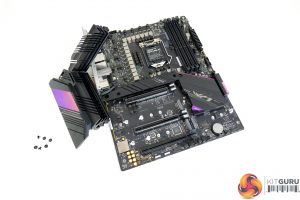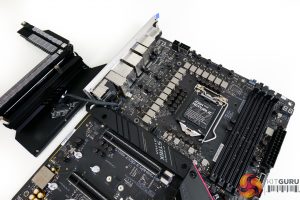The ROG STRIX Z590-E Gaming WiFi continues the largely black and grey styling but also adds some tints of pink and also blue/purple holographic sections. People have complained about the holographic STRIX logo so I will leave you to form your own opinion. There is good, subtle RGB onboard through different lighting zones.
Notably the board is very space constrained around the CPU area, especially for an ATX offering. We did, however, manage to fit an Asetek pump unit without issues, as well as a big EKWB water block.
CPU power is delivered through 8-pin + 4-pin connectors. Internally, you also get four RGB headers – two near the top and two near the bottom. A 2-digit debug LED is great to see alongside the POST LEDs, but I would have liked onboard power buttons. 20Gbps USB 3.2 Gen 2×2 through the internal Type-C header is a superb inclusion. And you get eight total fan headers, seven of which are 12W/1A but the water pump headers is 3A/36W. Quantity, positioning and spread is excellent for the headers, and I appreciate the AIO pump allocated one right next to the CPU socket.
Two steel-reinforced full-length PCIe slots serve as the main expansion points. These run at PCIe Gen 4 with an 11th Gen CPU and are split as x16/x0 or x8/x8 and can be bifurcated further. There is good spacing for triple slot cards and SLI is supported, but not even Jensen cares about that. The bottom full-length slot is PCIe Gen 3 x4 from the chipset. It shares two lanes of bandwidth with SATA 5/6 so watch out for that.
ASUS deploys four M.2 slots in total. The top slot is PCIe Gen 4 x4 from an 11th Gen CPU and only works with 11th Gen CPUs. The slot is annoying as the heatsink has an RGB cable connected to it and is therefore less easy to access. M.2 slot 2 shares bandwidth with the secondary full-length expansion slot, meaning that it can run at PCIe Gen 4 x4 with 11th Gen CPUs or Gen 3 x4 with 10th Gen chips. This drops the secondary expansion slot to a PCIe x4 link and will steal bandwidth from the primary slot graphics card by dropping it to x8. In other words, use M.2 Slot 2 as a last resort.
M.2 slot 3 runs from the Z590 chipset for PCIe Gen 3 x4 SSDs. M.2 Slot 4 is the same but adds support for SATA M.2 SSDs by stealing one of the physical port’s lanes. Bandwidth allocation for the M.2 slots is very good and you can realistically run all four SSDs simultaneously on an 11th Gen CPU with minimal downsides, provided you are happy with an x8 graphics card.
ASUS’ heatsinks are solid, and the tool-less design is fantastic. This method of SSD installation is a real stroke of innovation from ASUS and it is something that I appreciate. The annoying little M.2 screws are replaced by a straightforward and incredibly functional tool-less clip – Good job ASUS! ASUS also writes the information for slots on the PCB which is very smart and helpful.
Rear IO is very good for this type of motherboard. You get eight USB Type-A ports – 2x 10Gbps USB 3.2 Gen 2, 4x 5Gbps USB 3.2 Gen 1 (USB 3.0), and 2x old USB 2.0 ports including one which handles BIOS Flashback. Type-C comes in the form of a 10Gbps port and a 20Gbps USB 3.2 Gen 2×2 port which is a great inclusion. There is no TB4, which is fine for this board as the Z590-E Gaming WiFi deploys an excellent USB configuration overall.
Two Intel I225V 2.5GbE NICs and Intel AX210 2×2 WiFi 6E support are ideal. It is good to see dual high-speed NICs on an expensive board. Full-sized HDMI 2.0 and DP 1.4 serve 4K60 video outputs. The rear clear CMOS button is very handy, as are the full array of Realtek ALC4080-powered audio connectors. This is a superb rear IO configuration for a motherboard of this calibre.
ASUS deploys a massive, multi-tiered VRM heatsink that is linked via a heatpipe and integrates the rear IO cover. The design is absolutely fine as there is so much surface area and bulk metal that cooling will be strong. Contact is made with the MOSFETs and the chokes, which is good to see. There is no fan installed by default and I am very happy with this as it will not be needed alongside case airflow. ASUS does, however, include a fan mount rail by default and has a dedicated VRM fan header nearby. The bundle does actually include a small 40mm fan but I don’t see the need for this.
The power delivery solution itself is a design with 17 total stages split as 14+2+1. A high-quality Intersil ISL69269 PWM controller manages the system without doublers. 14x 70A-rated Texas Instruments 59880 power stages are used for the CPU VCore in a Teamed configuration. This gives a peak theoretical 980 Amps current output for the CPU VCore.
Nine CPU VCore stages are to the left side and five are to the top side. This makes perfect sense given the heatsink mass bias. Rounding out the VRM configuration are 5K-rated MIL capacitors. This is a high-end power delivery solution that will have no trouble with Intel 10th or 11th Gen CPUs outside of extreme OC.
Be sure to check out our sponsors store EKWB here
 KitGuru KitGuru.net – Tech News | Hardware News | Hardware Reviews | IOS | Mobile | Gaming | Graphics Cards
KitGuru KitGuru.net – Tech News | Hardware News | Hardware Reviews | IOS | Mobile | Gaming | Graphics Cards


